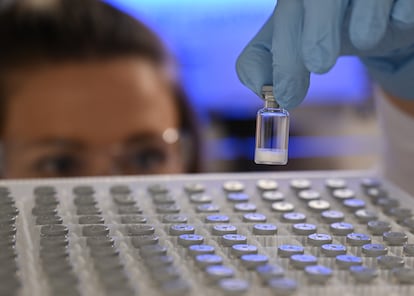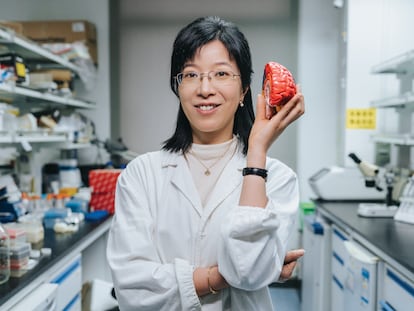The enormous but unknown curative power of old drugs
A legislative reform being prepared by the European Union plans to promote the use of already approved drugs to treat other illnesses. Doing so will speed up the approval of treatments and save on research costs

Nick Sireau was about to change his newborn son’s diapers when he discovered a large, dark reddish stain on them. It was a Sunday in October 2000, and the then-27-year-old aid worker’s life was about to change radically. “The emergency doctor came, but he couldn’t find anything. He said that maybe it was because of the color of the red cabbage my wife had eaten, that it could have passed into her breast milk and then into his urine. We didn’t know until later that it was really alkaptonuria,” he recalls. Sireau’s second son also has this condition, a rare genetic disease that manifests itself in the darkening of certain tissues and arthritis in the spine.
Almost 20 years later, on September 17, 2020, the European Medicines Agency (EMA) approved the first treatment for alkaptonuria, a drug called nitisinone. The medicine was not new; it had been used for many years to treat another condition (hereditary tyrosinemia type I). The research driven by Sireau’s quest to find a cure for his children served to demonstrate to the EMA that the drug was also effective against alkaptonuria. “It was a 20-year journey with ups and downs, but [it’s been] very rewarding. Along with other patients and doctors, we managed to mobilize €20 million and push for two clinical trials. Fortunately, all this has helped my children and others to live much better lives today,” he observes.
The repurposing of drugs is the use of therapies already approved for other diseases to treat new ailments, something that the European Union plans to promote with the legislative reform it is carrying out in the pharmaceutical field. “This is an area with enormous potential where it is essential to make progress. We have 7,000 rare diseases described, but fewer than 1,000 have a pharmacological treatment. Developing all these drugs from scratch would cost the equivalent of twice the GDP of Germany (about €8 billion), which is unaffordable. But if we take approved molecules, about which we already know a lot, and investigate their potential against other diseases, we can reach the target much sooner and for less money,” sums up Adrian van den Hoven, the director of Medicines for Europe, an organization of generic and biosimilar manufacturers.
Last week, Van den Hoven and Sireau spoke at the international Bridging Boundaries conference in Barcelona, Spain. Organized by REMEDi4ALL — a consortium financed by the European Union — and other entities, the gathering brought together 240 specialists from all over the world at the Sant Pau Hospital Historic Site.

Prescribing drugs for ailments or indications other than those listed on the label — known as off-label use — is actually a standard practice in medicine. But experts agree that it is not ideal. Firstly, the knowledge on which the decision to use off-label drugs is based is not comparable to the precision in efficacy, dose and safety data obtained through the trials that agencies like the EMA require to approve a drug.
Secondly, it is also a question of “equity,” argues Donald Lo, the director of drug development at the European Infrastructure for Translational Medicine (EATRIS), a consortium of European research centers. “Off-label use can be very socially unfair. To benefit from it, you depend on your doctor reading all the scientific literature and keeping up with the latest developments. And that happens more in large hospitals. Ninety percent of patients are not treated there, so many may go without the treatment they need. EMA approval is the best guarantee that medical advances reach everyone,” adds Lo.
Although desirable, obtaining EMA approval is not easy, even when knowledge about a drug’s benefits is well established in a specialty. Experts point to two reasons for this. “[Drug approval] is a very technically demanding process. Evidence has to be produced under very strict and costly quality standards. This is something that pharmaceutical companies know how to do very well. But then we have a lot of excellent academic research [from universities, public hospitals, research centers...] that, when it comes down to it, is not helpful in getting that approval,” says Anton Ussi, the chief operating officer at EATRIS.
The lack of incentive is the second major issue. “Old drugs are no longer protected by a patent and generic companies sell them very cheaply, so what pharmaceutical company is going to invest millions of euros in clinical trials if they are only going to be paid a few cents per pill?” asks Ussi.
In fact, European regulations do include some measures to encourage research in these cases, such as orphan drugs. The problem is that it is not applicable in many cases, and when it is, it has often been involved in abusive practices. A well-known example is what the Leadiant Biosciences pharmaceutical company did with chenodeoxycholic acid, a cheap drug with decades of history (the pill was sold for 14 cents). After obtaining exclusive marketing rights to the pill thanks to its status as an orphan drug, the company raised its price by 1,000-fold without having invested a single euro in new trials.
One possible solution for boosting research would be the creation of a third category of drugs. “It would be something in between the new innovative therapies, which are much more expensive, and generics, which are very inexpensive. The main question is: How should repurposed drugs be priced to make it attractive to invest in them while also keeping them affordable?” asks Zsuzsanna Petyko of the Syreon Reserach Institute, a Budapest-based research center.
But making investment more attractive to the industry is only part of the solution. The other is facilitating access to EMA approval for all the academic research from universities, hospitals and public research centers. “We are not taking advantage of all this knowledge, and it is an unacceptable waste. Fortunately, new opportunities are opening up for us. The legislative reform being taken up by the European Union plans to create a framework for drug repurposing; in a way, it will allow the two worlds — industry and academia — to meet,” says Van den Hoven.
Sini Eskola, the director of regulatory strategy at EFPIA (the European employers’ association for innovative pharmaceutical companies) insists that “repurposing should not be seen as a substitute for developing new drugs,” but rather as “a new opportunity for drugs that are no longer patented and a [source of] hope for patients suffering from conditions for which there are few or no drugs.”
Several repurposing success stories were presented at the conference in Barcelona. Rosie Lovett, the director of the drug repurposing program at the National Health Service (NHS) in England, discussed the example of anastrozole, a treatment with a 30-year history against breast cancer and therefore an expired patent. Clinical trials have shown that, if used as a preventive, the drug “reduces the incidence of the disease in postmenopausal women at increased risk of developing it by almost 50%,” which could prevent 2,000 cases a year.
Heather Stone, of the U.S. Food and Drug Administration (FDA), highlighted the potential of nitroxoline — an antimicrobial that has been used for half a century in Europe and China but is not approved in the United States — against a rare type of encephalitis (caused by the amoeba Balamuthia mandrillaris) that is fatal in 75% to 90% of cases. She recounted that two patients with very poor prognoses recovered after being treated with the drug, which the agency had to import into the United States as an exception.
Stone, who works at the FDA’s Center for Drug Evaluation and Research, explains how candidate molecules are selected for repurposing: “Potential treatments are often identified through so-called high-throughput screens, to which thousands of FDA- and EMA-approved drugs are subjected in pursuit of particular targets and mechanisms of action. But, unfortunately, there is a wealth of information that is hidden in clinical experience, scattered across many sources and formats that is difficult to aggregate, or in physician and patient experiences that are never made public. All of this is a valuable source of knowledge that should be tapped into,” she says.
Claudia Fuchs, a neurobiologist who works at the EURORDIS alliance of patient organizations, offered another example: ketamine was originally an anesthetic but since 2019 it has also been used to treat severe depression. “Drug repurposing can be very useful in all medical specialties, but perhaps cancer and rare diseases are [the areas] where there are more ailments for which there are no treatments available or where the ones that are available are no longer effective,” she observes.
In the field of infectious diseases, the coronavirus pandemic — a new pathogen for which there were no approved drugs — showed that repurposing is sometimes the only option. That will continue to be the case because, as Denis Kainov of the Norwegian University of Science and Technology explains, “it is very likely that viruses of animal origin will continue to be transmitted to humans. A key component of pandemic preparedness must be broad-spectrum antivirals, which are widely available to the population.” According to Kainov’s presentation, the repurpose of such antivirals against pathogens that are more or less similar to already known ones would buy time until vaccines and specific antivirals are developed.
As the EFPIA’s Eskola argued, “Although only a fraction of the drugs tested [in the early phases of the pandemic] proved effective, the efforts demonstrated the great speed with which repurposing can explore treatment options in uncharted territory. Technologies such as artificial intelligence, coupled with data-sharing platforms, improve the efficiency of drug repurposing.”
César Hernández, the Spanish Ministry of Health’s Director General of Pharmacy, who also attended the conference, warns of the risks of not repurposing a drug in time. One is that “it disappears from the market when it still has a real value for patients”; that has happened in the past with drugs like ketoconazole. Another risk is for “old drugs to re-enter the system as if they were new [medicines] at prices that are difficult to justify,” which is what happened in Europe with chenodeoxycholic acid.
Hernández highlights initiatives like the Spanish Agency for Medicines and Health Products’ project “promoting, along with a small group of agencies and the EMA, a pilot plan at the European level that influenced the European Pharmaceutical Strategy, where Spain pushed for its inclusion, and the legislation now in progress.” In this project, the EMA is working with non-profit organizations to repurpose 23 drugs.
Sign up for our weekly newsletter to get more English-language news coverage from EL PAÍS USA Edition
Tu suscripción se está usando en otro dispositivo
¿Quieres añadir otro usuario a tu suscripción?
Si continúas leyendo en este dispositivo, no se podrá leer en el otro.
FlechaTu suscripción se está usando en otro dispositivo y solo puedes acceder a EL PAÍS desde un dispositivo a la vez.
Si quieres compartir tu cuenta, cambia tu suscripción a la modalidad Premium, así podrás añadir otro usuario. Cada uno accederá con su propia cuenta de email, lo que os permitirá personalizar vuestra experiencia en EL PAÍS.
¿Tienes una suscripción de empresa? Accede aquí para contratar más cuentas.
En el caso de no saber quién está usando tu cuenta, te recomendamos cambiar tu contraseña aquí.
Si decides continuar compartiendo tu cuenta, este mensaje se mostrará en tu dispositivo y en el de la otra persona que está usando tu cuenta de forma indefinida, afectando a tu experiencia de lectura. Puedes consultar aquí los términos y condiciones de la suscripción digital.
More information
Archived In
Últimas noticias
Most viewed
- Sinaloa Cartel war is taking its toll on Los Chapitos
- Reinhard Genzel, Nobel laureate in physics: ‘One-minute videos will never give you the truth’
- Oona Chaplin: ‘I told James Cameron that I was living in a treehouse and starting a permaculture project with a friend’
- Why the price of coffee has skyrocketed: from Brazilian plantations to specialty coffee houses
- David King, chemist: ‘There are scientists studying how to cool the planet; nobody should stop these experiments from happening’











































